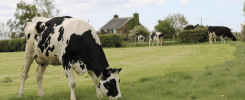Forage Technology Ltd, UK business partner to the world’s largest and ‘most sustainable biotech company – Chr Hansen A/S – are currently supplying Generation 2 microbial inoculants to treat 2,000,000 tonnes of UK silage each year. With such a large sample pool, we have a unique perspective on the difference between the good, the bad, and the downright ugly when it comes to silage-making.
Let’s start with some maths.
If silage is worth £ 45.00 per tonne, then why do we glibly accept losses from the field to the cow at an average of 27%? Would we accept a waggon load of 20 tonnes of feed, of which we tip 5 tonnes straight into the midden?
Let’s back up a moment – silage ‘worth £45 per tonne’. How about if we value it against the replacement cost? Dry matter is the amount of food in any given product, minus water, so silage might average 30% DM, concentrate might average 88% DM. Simple sum – if concentrate is £400 per tonne. that’s £454 per tonne of DM.
30% of that makes the silage value £136.20, and replacing that 27% loss on a 1,000 tonne crop is going to total around £37,000 – every year.
SiloSolve – nor any product, despite its claims – is a substitute for all the things that a farmer can do to make ‘more milk/meat from forage, but rather, the better the initial product and management, the greater the gains from the SiloSolve treatment. Here are our top pointers for great silage:
- The health of the soil creates the health and productivity of the crop. Decades of intensive slurry application can not only unbalance the entire microbial population, but deplete essential nutrients. Silage energy and protein start in this soil and end in either the milk tank, or behind the cow. It’s the feed that determines the year, and poor silage cannot be rescued by alternative feeds or concentrate. Poor silage drags down productivity, and every pallet of expensive supplements, fats, yeasts, mycotoxin binders, etc. bought to “fix” the cows simply won’t – poor silage wrecks rumen function.
- Harvesting younger, more nutritious material, with lower indigestible fibre levels makes sense, but it also brings its own problems. A higher buffering capacity (the ability to withstand pH change) means more extensive fermentation (conversion of plant sugars to predominantly lactic acid.) Too much lactic acid (especially in the presence of residual oxygen) is the feed source for the yeasts that create the heat that encourage the moulds that ruin the silage. Drier is better as it lowers the production of acid, but that requires high-quality clamp management as it’s more prone to oxygen ingress, especially the top third, which is never as well consolidated as the rest of the material.
Once the clamp is opened, and oxygen begins to creep through the face, many of the dormant problem organisms get a wake-up call.
Compaction is key. Feeding out, moving through the silage clamp at 0.5 metres a week, loss of DM – remember that’s the sugar and protein, not the indigestible fibre, so double the amount of potential feed value that is lost – in a 500 Kgs per m silage will be 10%, whereas in a 950 Kgs per m silage will be 2%.
Heating silage. First, there are two kinds of heating. One is the ‘thermal blanket effect which is actually evidence of good silage clamp management. For up to 120 days after harvest, a well-consolidated, oxygen-free, weighted clamp will retain much of the ambient temperature it was ensiled at, and a few degrees involved in the fermentation process. That heat dissipates rapidly when the silage is removed from the clamp, and TMR is cool and palatable. The other heat – called spoilage – is yeast and mould derived, and is due to sugar and protein destroying micro-organisms. SiloSolve is unique. Its patented oxygen scavenging ability (oxygen in the clamp gone in a few hours after ensiling) stops heat and other undesirable processes in their tracks. One product works on all crops and all dry matters. Contact us today to find out more.


